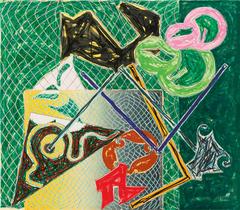Frank Stella V Series
Recent Sales
Shards V
By Frank Stella
Located in Boston, MA
Artist: Stella, Frank
Title: Shards V
Series: Shards (A.148)
Date: 1982
Medium: Lithograph
Category
1980s Contemporary Abstract Prints
Materials
Lithograph, Screen
The V Series - Complete 1960s Gemini G.E.L. Portfolio
By Frank Stella
Located in Köln, DE
Frank Stella – The V Series
Los Angeles: Gemini G.E.L., 1968
Absolutely rare promotional
Category
1960s Pop Art Abstract Prints
Materials
Paper
Get Updated with New Arrivals
Save "Frank Stella V Series", and we’ll notify you when there are new listings in this category.
More Ways To Browse
Jordy Kerwick
Jorge Oteiza Sculptures
Jose Barbera Paint
Jose Borrell On Sale
Jose Garcia Y Ramos
Josef M Arentz
Joseph Lepine
Joseph Levin
Joseph Louis Francois Lepine
Joseph Mcloughlin
Judith Evans
Judith Shea
Jules Gustave Leroy
Jules Machard
Julian Beck
June Nelson Artist
June Nelson Oil Painting
June Nelson Paintings
